COIT20248 Term 1 Assignment 1: Hospital Information System Analysis
VerifiedAdded on 2023/01/20
|16
|2912
|46
Report
AI Summary
This report presents a systematic analysis for instituting a Hospital Information System (HIS) in hospitals. It begins by selecting the Agile methodology for system development, justifying its iterative nature and adaptability to changing requirements. The report then identifies both functional requirements (user registration, patient records, appointment booking) and non-functional requirements (data storage capacity, system reliability, security, and data backup). A cost-benefit analysis reveals the economic feasibility of the project, with an ROI of 1.02 and a break-even point in 3.34 years. The project schedule, planned using a Work Breakdown Structure and Gantt chart, outlines a 99-day timeline for development, testing, and integration. The report also identifies stakeholders and investigates information requirement techniques such as interviews, surveys, and document analysis. In conclusion, the HIS is essential for efficient hospital data management, with the chosen approach and analysis supporting its successful implementation.

COIT 20248: Information Systems Analysis and Design
Term 1, 2019
Assessment 1 - Systems Development
Term 1, 2019
Assessment 1 - Systems Development
Paraphrase This Document
Need a fresh take? Get an instant paraphrase of this document with our AI Paraphraser
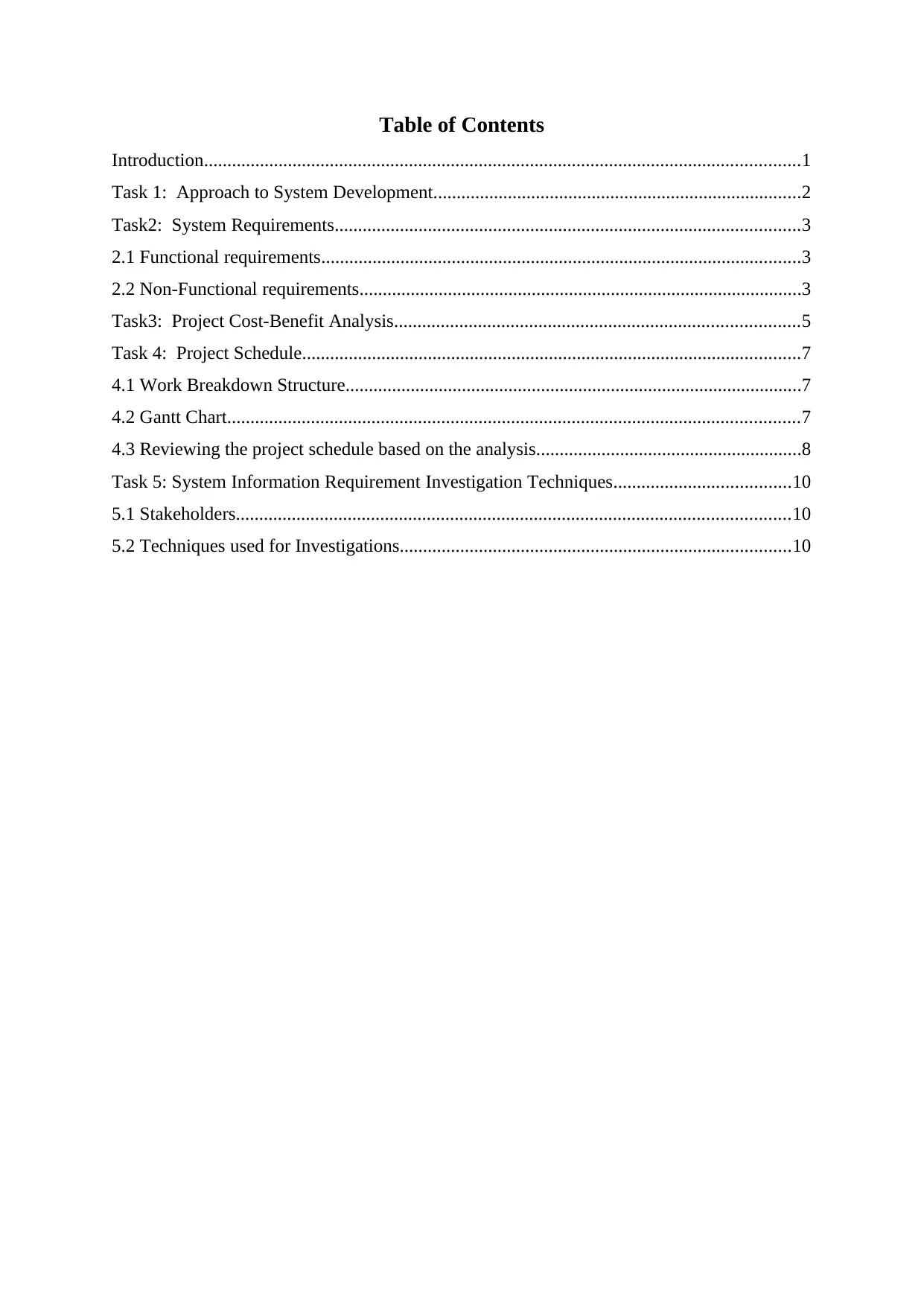
Table of Contents
Introduction................................................................................................................................1
Task 1: Approach to System Development...............................................................................2
Task2: System Requirements....................................................................................................3
2.1 Functional requirements.......................................................................................................3
2.2 Non-Functional requirements...............................................................................................3
Task3: Project Cost-Benefit Analysis.......................................................................................5
Task 4: Project Schedule...........................................................................................................7
4.1 Work Breakdown Structure..................................................................................................7
4.2 Gantt Chart...........................................................................................................................7
4.3 Reviewing the project schedule based on the analysis.........................................................8
Task 5: System Information Requirement Investigation Techniques......................................10
5.1 Stakeholders.......................................................................................................................10
5.2 Techniques used for Investigations....................................................................................10
Introduction................................................................................................................................1
Task 1: Approach to System Development...............................................................................2
Task2: System Requirements....................................................................................................3
2.1 Functional requirements.......................................................................................................3
2.2 Non-Functional requirements...............................................................................................3
Task3: Project Cost-Benefit Analysis.......................................................................................5
Task 4: Project Schedule...........................................................................................................7
4.1 Work Breakdown Structure..................................................................................................7
4.2 Gantt Chart...........................................................................................................................7
4.3 Reviewing the project schedule based on the analysis.........................................................8
Task 5: System Information Requirement Investigation Techniques......................................10
5.1 Stakeholders.......................................................................................................................10
5.2 Techniques used for Investigations....................................................................................10
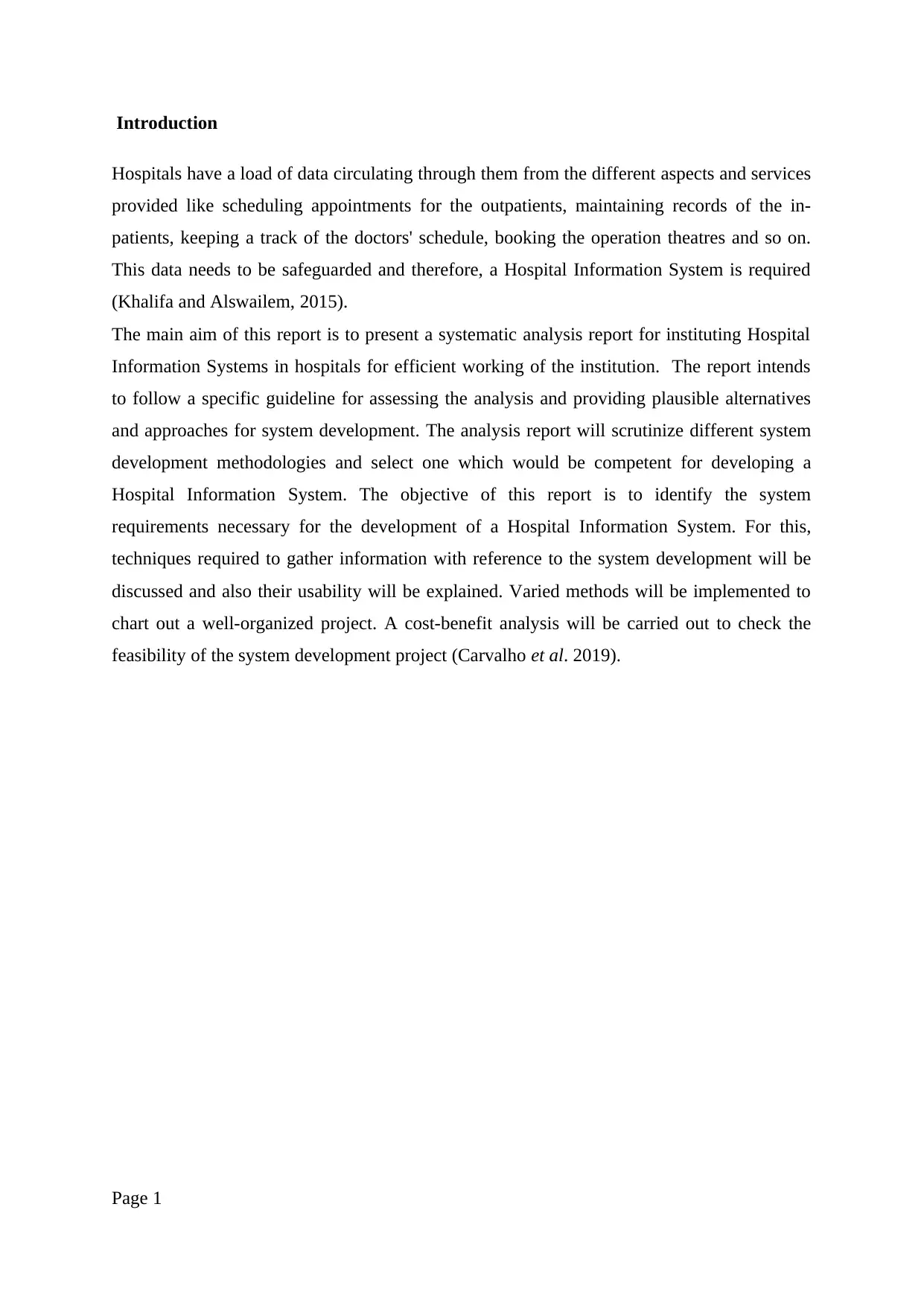
Introduction
Hospitals have a load of data circulating through them from the different aspects and services
provided like scheduling appointments for the outpatients, maintaining records of the in-
patients, keeping a track of the doctors' schedule, booking the operation theatres and so on.
This data needs to be safeguarded and therefore, a Hospital Information System is required
(Khalifa and Alswailem, 2015).
The main aim of this report is to present a systematic analysis report for instituting Hospital
Information Systems in hospitals for efficient working of the institution. The report intends
to follow a specific guideline for assessing the analysis and providing plausible alternatives
and approaches for system development. The analysis report will scrutinize different system
development methodologies and select one which would be competent for developing a
Hospital Information System. The objective of this report is to identify the system
requirements necessary for the development of a Hospital Information System. For this,
techniques required to gather information with reference to the system development will be
discussed and also their usability will be explained. Varied methods will be implemented to
chart out a well-organized project. A cost-benefit analysis will be carried out to check the
feasibility of the system development project (Carvalho et al. 2019).
Page 1
Hospitals have a load of data circulating through them from the different aspects and services
provided like scheduling appointments for the outpatients, maintaining records of the in-
patients, keeping a track of the doctors' schedule, booking the operation theatres and so on.
This data needs to be safeguarded and therefore, a Hospital Information System is required
(Khalifa and Alswailem, 2015).
The main aim of this report is to present a systematic analysis report for instituting Hospital
Information Systems in hospitals for efficient working of the institution. The report intends
to follow a specific guideline for assessing the analysis and providing plausible alternatives
and approaches for system development. The analysis report will scrutinize different system
development methodologies and select one which would be competent for developing a
Hospital Information System. The objective of this report is to identify the system
requirements necessary for the development of a Hospital Information System. For this,
techniques required to gather information with reference to the system development will be
discussed and also their usability will be explained. Varied methods will be implemented to
chart out a well-organized project. A cost-benefit analysis will be carried out to check the
feasibility of the system development project (Carvalho et al. 2019).
Page 1
⊘ This is a preview!⊘
Do you want full access?
Subscribe today to unlock all pages.

Trusted by 1+ million students worldwide
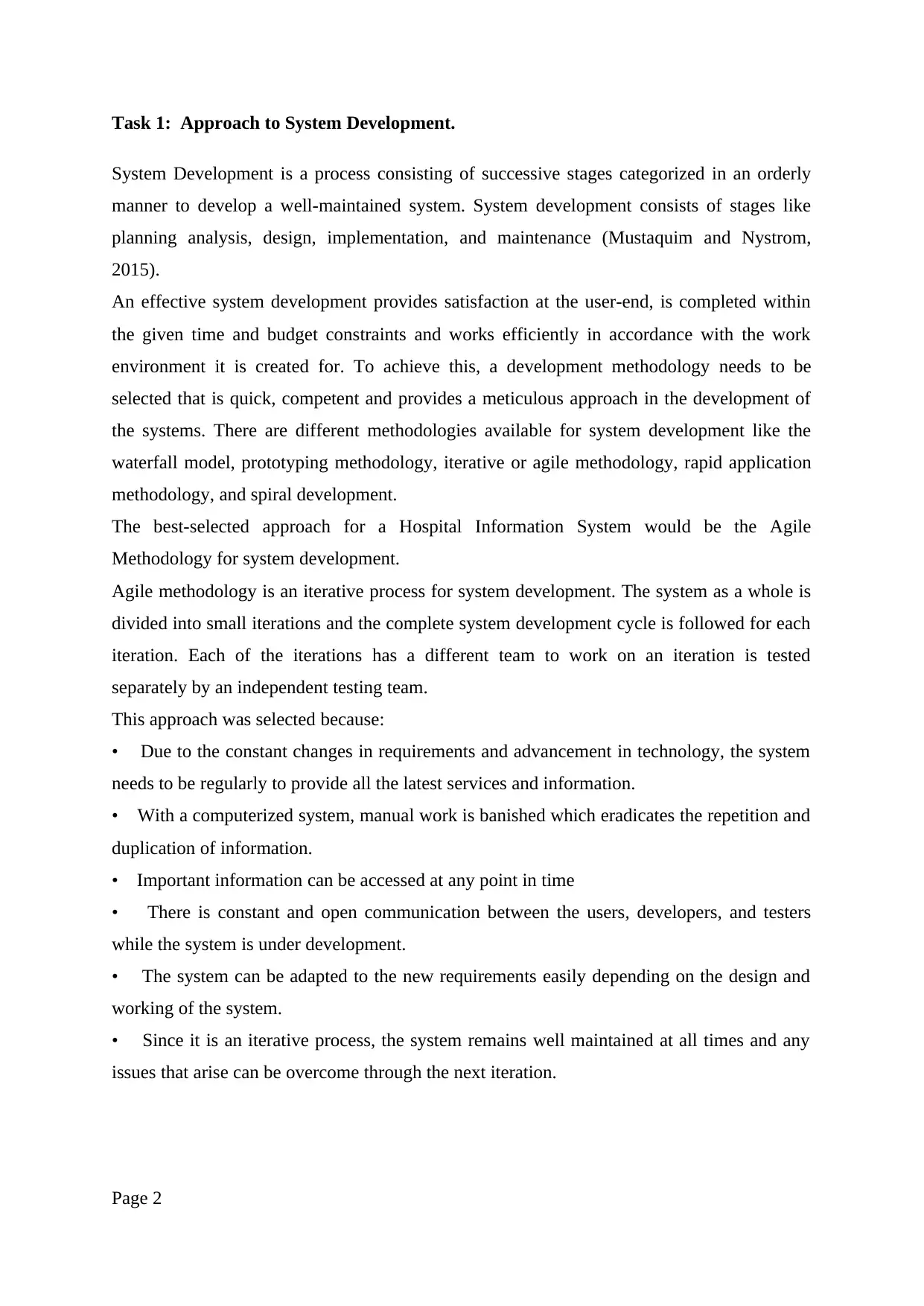
Task 1: Approach to System Development.
System Development is a process consisting of successive stages categorized in an orderly
manner to develop a well-maintained system. System development consists of stages like
planning analysis, design, implementation, and maintenance (Mustaquim and Nystrom,
2015).
An effective system development provides satisfaction at the user-end, is completed within
the given time and budget constraints and works efficiently in accordance with the work
environment it is created for. To achieve this, a development methodology needs to be
selected that is quick, competent and provides a meticulous approach in the development of
the systems. There are different methodologies available for system development like the
waterfall model, prototyping methodology, iterative or agile methodology, rapid application
methodology, and spiral development.
The best-selected approach for a Hospital Information System would be the Agile
Methodology for system development.
Agile methodology is an iterative process for system development. The system as a whole is
divided into small iterations and the complete system development cycle is followed for each
iteration. Each of the iterations has a different team to work on an iteration is tested
separately by an independent testing team.
This approach was selected because:
• Due to the constant changes in requirements and advancement in technology, the system
needs to be regularly to provide all the latest services and information.
• With a computerized system, manual work is banished which eradicates the repetition and
duplication of information.
• Important information can be accessed at any point in time
• There is constant and open communication between the users, developers, and testers
while the system is under development.
• The system can be adapted to the new requirements easily depending on the design and
working of the system.
• Since it is an iterative process, the system remains well maintained at all times and any
issues that arise can be overcome through the next iteration.
Page 2
System Development is a process consisting of successive stages categorized in an orderly
manner to develop a well-maintained system. System development consists of stages like
planning analysis, design, implementation, and maintenance (Mustaquim and Nystrom,
2015).
An effective system development provides satisfaction at the user-end, is completed within
the given time and budget constraints and works efficiently in accordance with the work
environment it is created for. To achieve this, a development methodology needs to be
selected that is quick, competent and provides a meticulous approach in the development of
the systems. There are different methodologies available for system development like the
waterfall model, prototyping methodology, iterative or agile methodology, rapid application
methodology, and spiral development.
The best-selected approach for a Hospital Information System would be the Agile
Methodology for system development.
Agile methodology is an iterative process for system development. The system as a whole is
divided into small iterations and the complete system development cycle is followed for each
iteration. Each of the iterations has a different team to work on an iteration is tested
separately by an independent testing team.
This approach was selected because:
• Due to the constant changes in requirements and advancement in technology, the system
needs to be regularly to provide all the latest services and information.
• With a computerized system, manual work is banished which eradicates the repetition and
duplication of information.
• Important information can be accessed at any point in time
• There is constant and open communication between the users, developers, and testers
while the system is under development.
• The system can be adapted to the new requirements easily depending on the design and
working of the system.
• Since it is an iterative process, the system remains well maintained at all times and any
issues that arise can be overcome through the next iteration.
Page 2
Paraphrase This Document
Need a fresh take? Get an instant paraphrase of this document with our AI Paraphraser
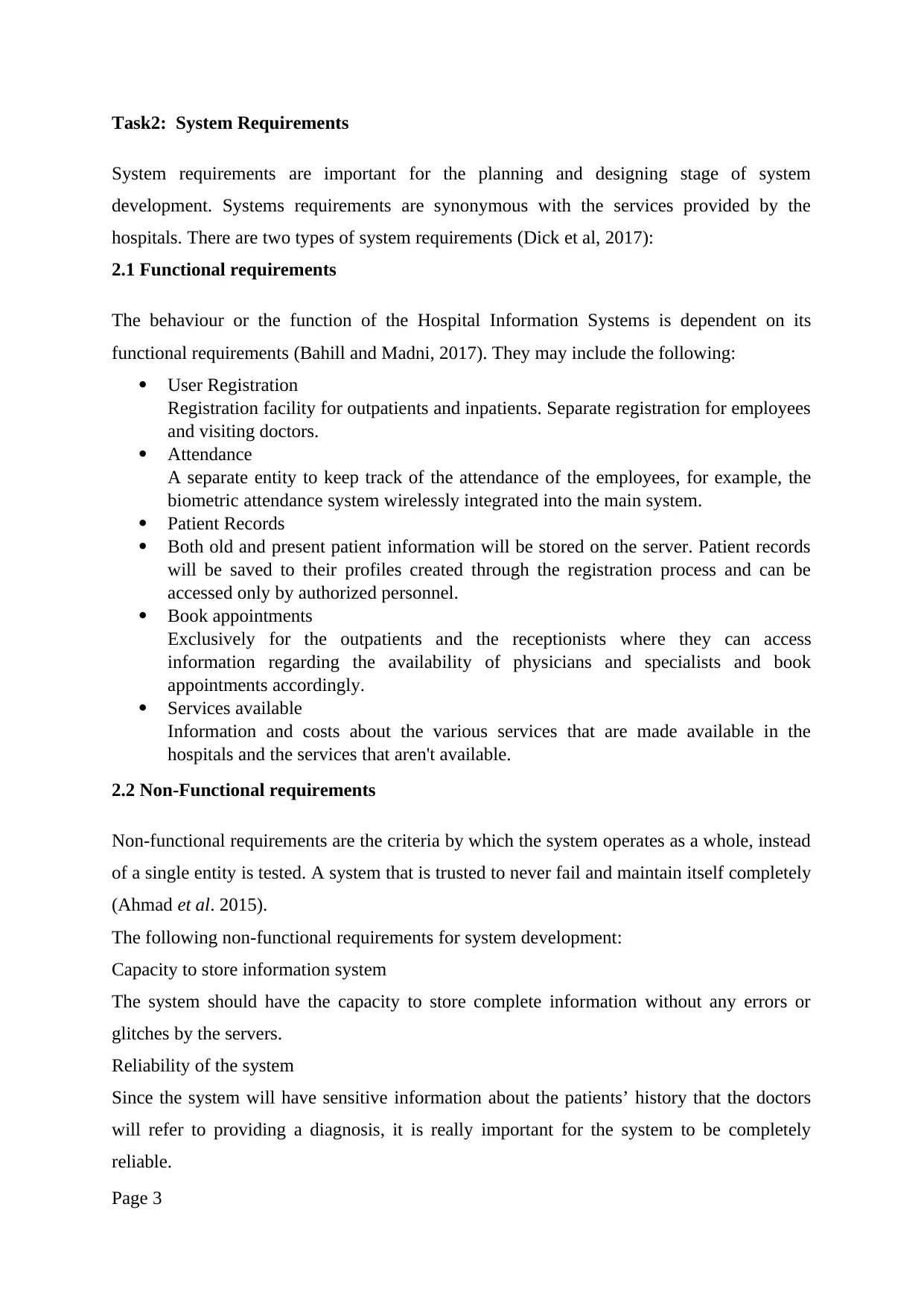
Task2: System Requirements
System requirements are important for the planning and designing stage of system
development. Systems requirements are synonymous with the services provided by the
hospitals. There are two types of system requirements (Dick et al, 2017):
2.1 Functional requirements
The behaviour or the function of the Hospital Information Systems is dependent on its
functional requirements (Bahill and Madni, 2017). They may include the following:
User Registration
Registration facility for outpatients and inpatients. Separate registration for employees
and visiting doctors.
Attendance
A separate entity to keep track of the attendance of the employees, for example, the
biometric attendance system wirelessly integrated into the main system.
Patient Records
Both old and present patient information will be stored on the server. Patient records
will be saved to their profiles created through the registration process and can be
accessed only by authorized personnel.
Book appointments
Exclusively for the outpatients and the receptionists where they can access
information regarding the availability of physicians and specialists and book
appointments accordingly.
Services available
Information and costs about the various services that are made available in the
hospitals and the services that aren't available.
2.2 Non-Functional requirements
Non-functional requirements are the criteria by which the system operates as a whole, instead
of a single entity is tested. A system that is trusted to never fail and maintain itself completely
(Ahmad et al. 2015).
The following non-functional requirements for system development:
Capacity to store information system
The system should have the capacity to store complete information without any errors or
glitches by the servers.
Reliability of the system
Since the system will have sensitive information about the patients’ history that the doctors
will refer to providing a diagnosis, it is really important for the system to be completely
reliable.
Page 3
System requirements are important for the planning and designing stage of system
development. Systems requirements are synonymous with the services provided by the
hospitals. There are two types of system requirements (Dick et al, 2017):
2.1 Functional requirements
The behaviour or the function of the Hospital Information Systems is dependent on its
functional requirements (Bahill and Madni, 2017). They may include the following:
User Registration
Registration facility for outpatients and inpatients. Separate registration for employees
and visiting doctors.
Attendance
A separate entity to keep track of the attendance of the employees, for example, the
biometric attendance system wirelessly integrated into the main system.
Patient Records
Both old and present patient information will be stored on the server. Patient records
will be saved to their profiles created through the registration process and can be
accessed only by authorized personnel.
Book appointments
Exclusively for the outpatients and the receptionists where they can access
information regarding the availability of physicians and specialists and book
appointments accordingly.
Services available
Information and costs about the various services that are made available in the
hospitals and the services that aren't available.
2.2 Non-Functional requirements
Non-functional requirements are the criteria by which the system operates as a whole, instead
of a single entity is tested. A system that is trusted to never fail and maintain itself completely
(Ahmad et al. 2015).
The following non-functional requirements for system development:
Capacity to store information system
The system should have the capacity to store complete information without any errors or
glitches by the servers.
Reliability of the system
Since the system will have sensitive information about the patients’ history that the doctors
will refer to providing a diagnosis, it is really important for the system to be completely
reliable.
Page 3

Security regarding data.
Private information will be stored on the system like patient history, medical reports that need
to be secured. MD5 encoding must be incorporated along with other encoding techniques to
maintain the authenticity of the system.
Data Backup
The system should allow auto backup of personal data on a cloud server in case of technical
faults like system shut down, network issues, and security breach.
Page 4
Private information will be stored on the system like patient history, medical reports that need
to be secured. MD5 encoding must be incorporated along with other encoding techniques to
maintain the authenticity of the system.
Data Backup
The system should allow auto backup of personal data on a cloud server in case of technical
faults like system shut down, network issues, and security breach.
Page 4
⊘ This is a preview!⊘
Do you want full access?
Subscribe today to unlock all pages.

Trusted by 1+ million students worldwide
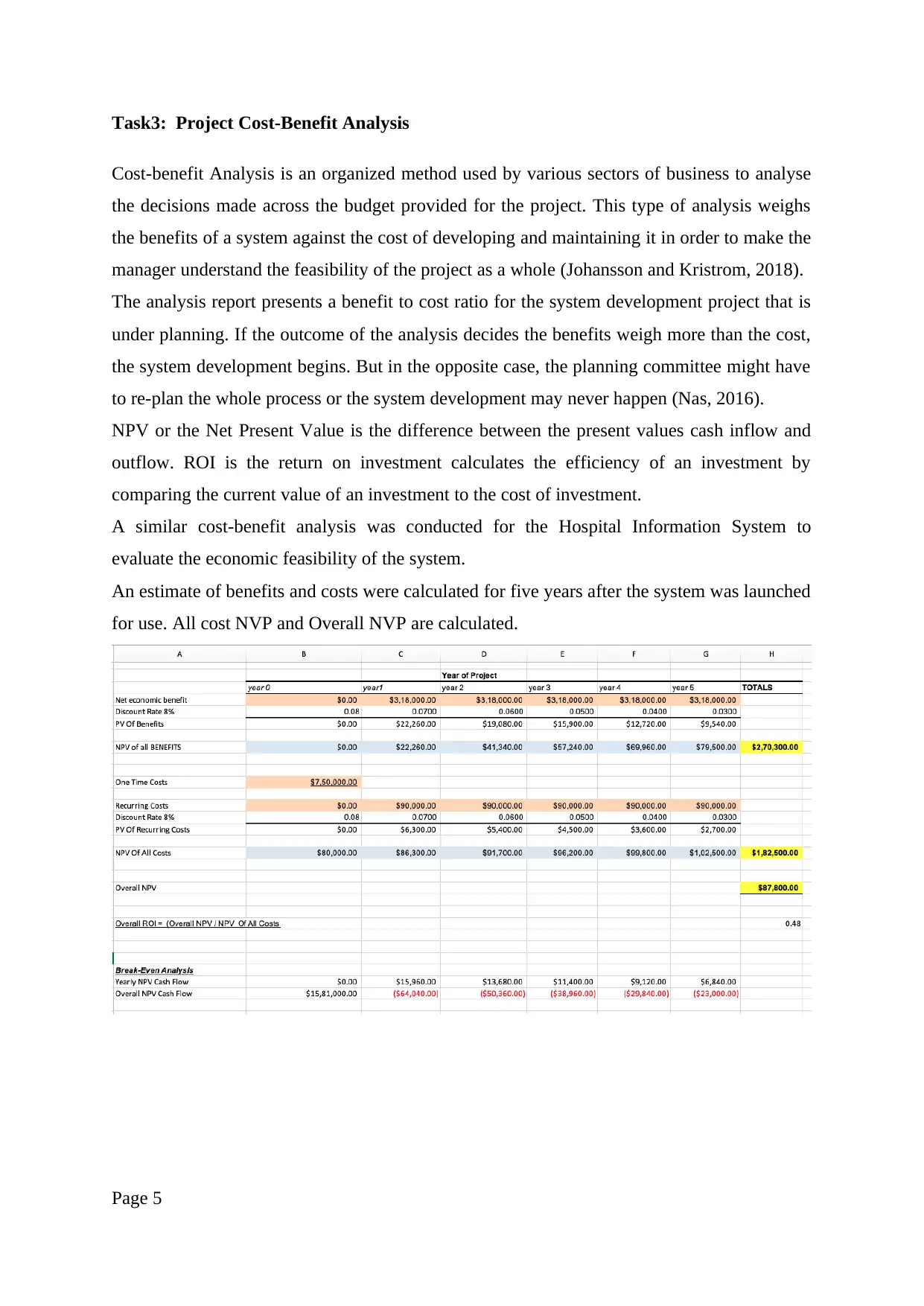
Task3: Project Cost-Benefit Analysis
Cost-benefit Analysis is an organized method used by various sectors of business to analyse
the decisions made across the budget provided for the project. This type of analysis weighs
the benefits of a system against the cost of developing and maintaining it in order to make the
manager understand the feasibility of the project as a whole (Johansson and Kristrom, 2018).
The analysis report presents a benefit to cost ratio for the system development project that is
under planning. If the outcome of the analysis decides the benefits weigh more than the cost,
the system development begins. But in the opposite case, the planning committee might have
to re-plan the whole process or the system development may never happen (Nas, 2016).
NPV or the Net Present Value is the difference between the present values cash inflow and
outflow. ROI is the return on investment calculates the efficiency of an investment by
comparing the current value of an investment to the cost of investment.
A similar cost-benefit analysis was conducted for the Hospital Information System to
evaluate the economic feasibility of the system.
An estimate of benefits and costs were calculated for five years after the system was launched
for use. All cost NVP and Overall NVP are calculated.
Page 5
Cost-benefit Analysis is an organized method used by various sectors of business to analyse
the decisions made across the budget provided for the project. This type of analysis weighs
the benefits of a system against the cost of developing and maintaining it in order to make the
manager understand the feasibility of the project as a whole (Johansson and Kristrom, 2018).
The analysis report presents a benefit to cost ratio for the system development project that is
under planning. If the outcome of the analysis decides the benefits weigh more than the cost,
the system development begins. But in the opposite case, the planning committee might have
to re-plan the whole process or the system development may never happen (Nas, 2016).
NPV or the Net Present Value is the difference between the present values cash inflow and
outflow. ROI is the return on investment calculates the efficiency of an investment by
comparing the current value of an investment to the cost of investment.
A similar cost-benefit analysis was conducted for the Hospital Information System to
evaluate the economic feasibility of the system.
An estimate of benefits and costs were calculated for five years after the system was launched
for use. All cost NVP and Overall NVP are calculated.
Page 5
Paraphrase This Document
Need a fresh take? Get an instant paraphrase of this document with our AI Paraphraser

NPV for all costs for hospitals is $182500 and the Overall NPV is $87,800. The Return on
Investment or ROI is calculated by dividing the NPV of all costs by the Overall NPV. For
this system, the ROI is 1.02. The break-even occurs between year 2 and 3. Actual break-even
is 3.34 years i.e. the payback period for the system development is 3.5 years. Therefore, the
Hospital Management System is economically feasible.
Page 6
Investment or ROI is calculated by dividing the NPV of all costs by the Overall NPV. For
this system, the ROI is 1.02. The break-even occurs between year 2 and 3. Actual break-even
is 3.34 years i.e. the payback period for the system development is 3.5 years. Therefore, the
Hospital Management System is economically feasible.
Page 6
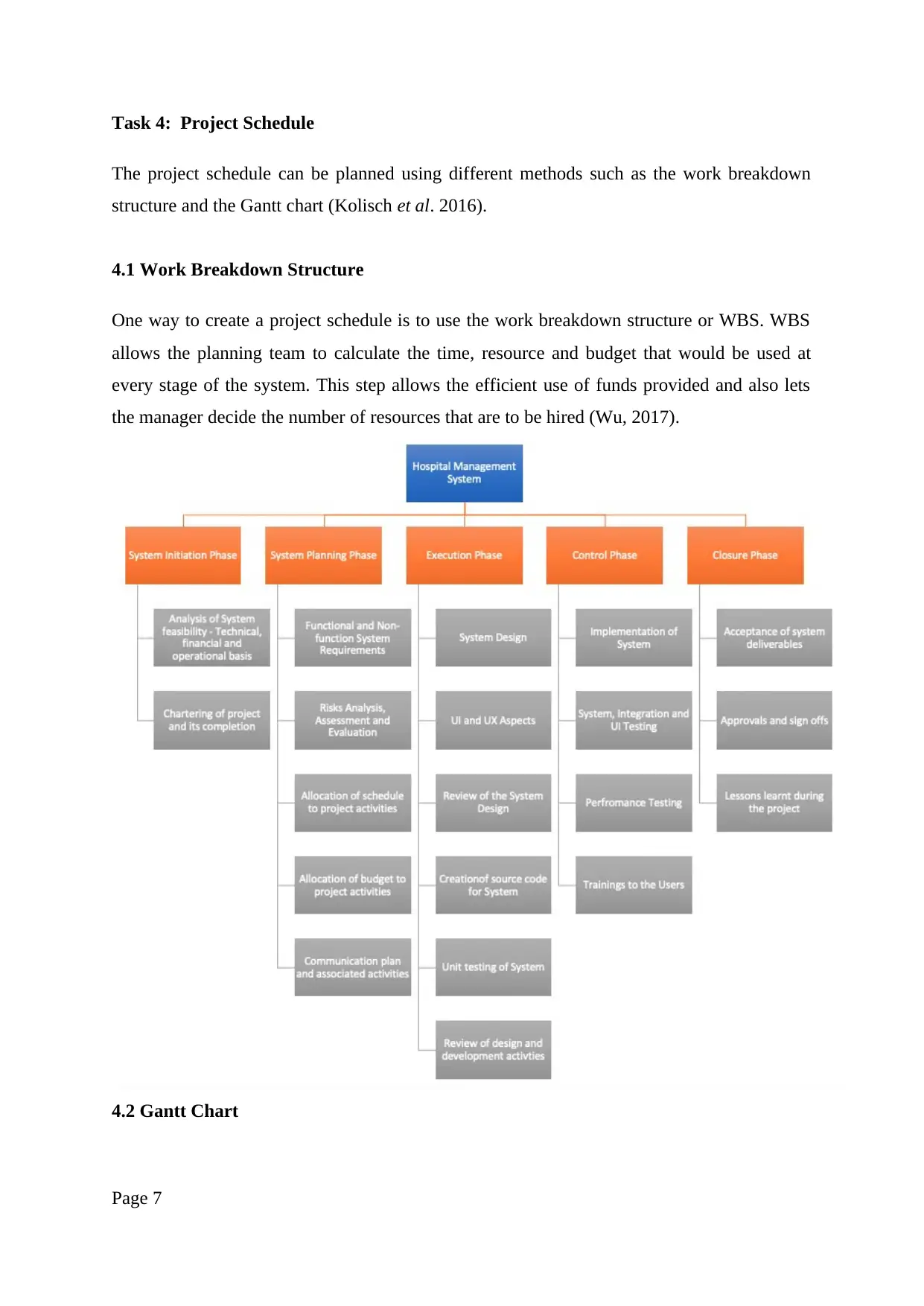
Task 4: Project Schedule
The project schedule can be planned using different methods such as the work breakdown
structure and the Gantt chart (Kolisch et al. 2016).
4.1 Work Breakdown Structure
One way to create a project schedule is to use the work breakdown structure or WBS. WBS
allows the planning team to calculate the time, resource and budget that would be used at
every stage of the system. This step allows the efficient use of funds provided and also lets
the manager decide the number of resources that are to be hired (Wu, 2017).
4.2 Gantt Chart
Page 7
The project schedule can be planned using different methods such as the work breakdown
structure and the Gantt chart (Kolisch et al. 2016).
4.1 Work Breakdown Structure
One way to create a project schedule is to use the work breakdown structure or WBS. WBS
allows the planning team to calculate the time, resource and budget that would be used at
every stage of the system. This step allows the efficient use of funds provided and also lets
the manager decide the number of resources that are to be hired (Wu, 2017).
4.2 Gantt Chart
Page 7
⊘ This is a preview!⊘
Do you want full access?
Subscribe today to unlock all pages.

Trusted by 1+ million students worldwide
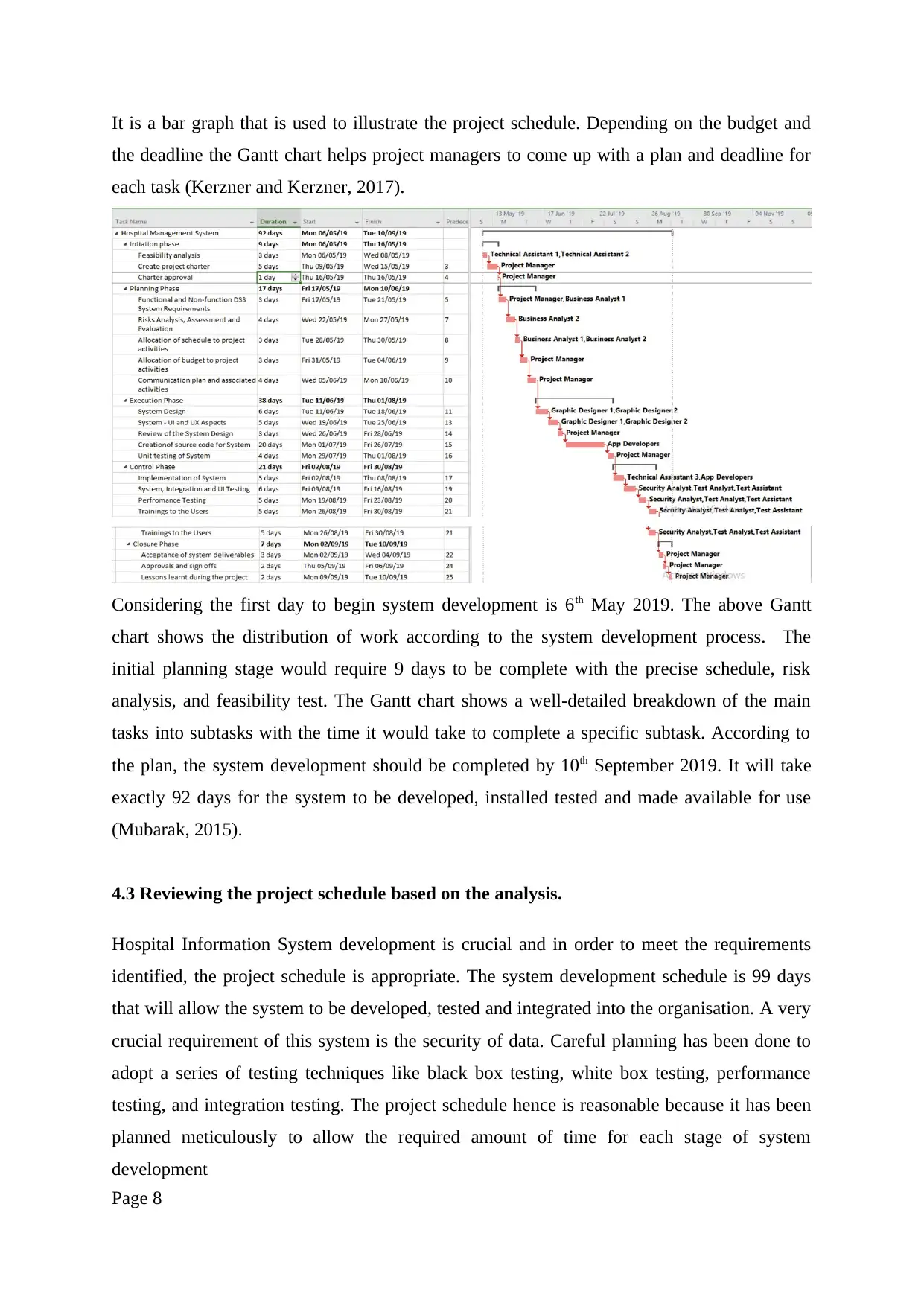
It is a bar graph that is used to illustrate the project schedule. Depending on the budget and
the deadline the Gantt chart helps project managers to come up with a plan and deadline for
each task (Kerzner and Kerzner, 2017).
Considering the first day to begin system development is 6th May 2019. The above Gantt
chart shows the distribution of work according to the system development process. The
initial planning stage would require 9 days to be complete with the precise schedule, risk
analysis, and feasibility test. The Gantt chart shows a well-detailed breakdown of the main
tasks into subtasks with the time it would take to complete a specific subtask. According to
the plan, the system development should be completed by 10th September 2019. It will take
exactly 92 days for the system to be developed, installed tested and made available for use
(Mubarak, 2015).
4.3 Reviewing the project schedule based on the analysis.
Hospital Information System development is crucial and in order to meet the requirements
identified, the project schedule is appropriate. The system development schedule is 99 days
that will allow the system to be developed, tested and integrated into the organisation. A very
crucial requirement of this system is the security of data. Careful planning has been done to
adopt a series of testing techniques like black box testing, white box testing, performance
testing, and integration testing. The project schedule hence is reasonable because it has been
planned meticulously to allow the required amount of time for each stage of system
development
Page 8
the deadline the Gantt chart helps project managers to come up with a plan and deadline for
each task (Kerzner and Kerzner, 2017).
Considering the first day to begin system development is 6th May 2019. The above Gantt
chart shows the distribution of work according to the system development process. The
initial planning stage would require 9 days to be complete with the precise schedule, risk
analysis, and feasibility test. The Gantt chart shows a well-detailed breakdown of the main
tasks into subtasks with the time it would take to complete a specific subtask. According to
the plan, the system development should be completed by 10th September 2019. It will take
exactly 92 days for the system to be developed, installed tested and made available for use
(Mubarak, 2015).
4.3 Reviewing the project schedule based on the analysis.
Hospital Information System development is crucial and in order to meet the requirements
identified, the project schedule is appropriate. The system development schedule is 99 days
that will allow the system to be developed, tested and integrated into the organisation. A very
crucial requirement of this system is the security of data. Careful planning has been done to
adopt a series of testing techniques like black box testing, white box testing, performance
testing, and integration testing. The project schedule hence is reasonable because it has been
planned meticulously to allow the required amount of time for each stage of system
development
Page 8
Paraphrase This Document
Need a fresh take? Get an instant paraphrase of this document with our AI Paraphraser

Page 9
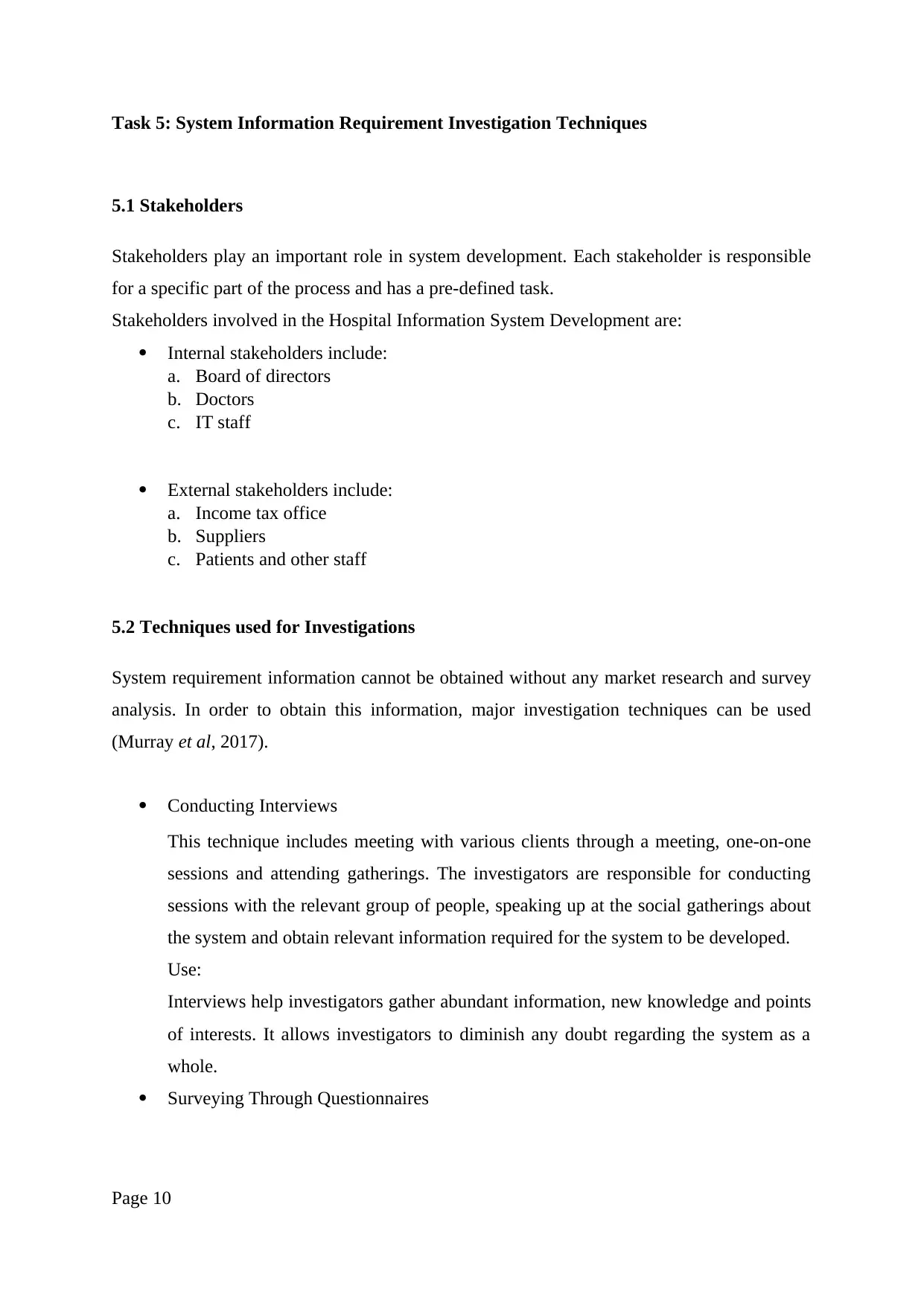
Task 5: System Information Requirement Investigation Techniques
5.1 Stakeholders
Stakeholders play an important role in system development. Each stakeholder is responsible
for a specific part of the process and has a pre-defined task.
Stakeholders involved in the Hospital Information System Development are:
Internal stakeholders include:
a. Board of directors
b. Doctors
c. IT staff
External stakeholders include:
a. Income tax office
b. Suppliers
c. Patients and other staff
5.2 Techniques used for Investigations
System requirement information cannot be obtained without any market research and survey
analysis. In order to obtain this information, major investigation techniques can be used
(Murray et al, 2017).
Conducting Interviews
This technique includes meeting with various clients through a meeting, one-on-one
sessions and attending gatherings. The investigators are responsible for conducting
sessions with the relevant group of people, speaking up at the social gatherings about
the system and obtain relevant information required for the system to be developed.
Use:
Interviews help investigators gather abundant information, new knowledge and points
of interests. It allows investigators to diminish any doubt regarding the system as a
whole.
Surveying Through Questionnaires
Page 10
5.1 Stakeholders
Stakeholders play an important role in system development. Each stakeholder is responsible
for a specific part of the process and has a pre-defined task.
Stakeholders involved in the Hospital Information System Development are:
Internal stakeholders include:
a. Board of directors
b. Doctors
c. IT staff
External stakeholders include:
a. Income tax office
b. Suppliers
c. Patients and other staff
5.2 Techniques used for Investigations
System requirement information cannot be obtained without any market research and survey
analysis. In order to obtain this information, major investigation techniques can be used
(Murray et al, 2017).
Conducting Interviews
This technique includes meeting with various clients through a meeting, one-on-one
sessions and attending gatherings. The investigators are responsible for conducting
sessions with the relevant group of people, speaking up at the social gatherings about
the system and obtain relevant information required for the system to be developed.
Use:
Interviews help investigators gather abundant information, new knowledge and points
of interests. It allows investigators to diminish any doubt regarding the system as a
whole.
Surveying Through Questionnaires
Page 10
⊘ This is a preview!⊘
Do you want full access?
Subscribe today to unlock all pages.

Trusted by 1+ million students worldwide
1 out of 16
Related Documents
Your All-in-One AI-Powered Toolkit for Academic Success.
+13062052269
info@desklib.com
Available 24*7 on WhatsApp / Email
![[object Object]](/_next/static/media/star-bottom.7253800d.svg)
Unlock your academic potential
Copyright © 2020–2025 A2Z Services. All Rights Reserved. Developed and managed by ZUCOL.




